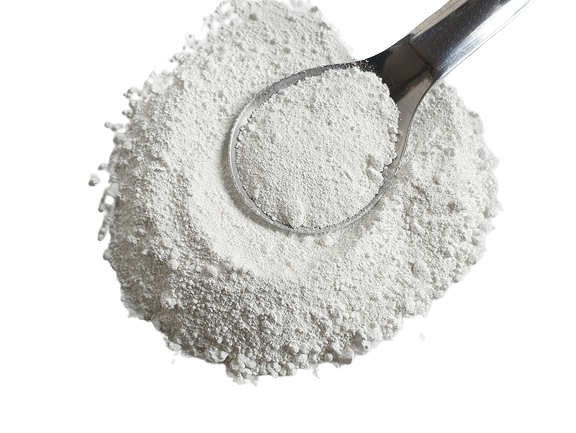Titanium Dioxide
Titanium dioxide also knowns as titanium(IV) or titania s a simple inorganic compound produced as a pure white powder with the chemical formula TiO2. It is the naturally occurring oxide of titanium and it is sourced from various minerals such as ilmenite, rutile and anatase. The production method of Titanium oxide depends on the available feedstock mineral ore material. Limenite, Anatase and Rutile are commercial mineral feedstock ore materials for titanium oxide production.


Manufacturing Process
The most commercial method for the production of titanium dioxide uses the mineral ilmenite, mixed with sulfuric acid. The by-product iron(II) sulfate is crystallized and filtered-off to yield only the titanium salt in the digestion solution. This product is called synthetic rutile. Rutile is the second most abundant raw material for manufacturing of titanium oxide. The Crude titanium dioxide is purified by converting it to titanium tetrachloride using the chloride process Anatase can be converted by hydrothermal synthesis to inorganic titanium dioxide nanotubes and this method has much more potential application in nanotechnology. One method for the production of titanium dioxide with relevance to nanotechnology is solvothermal Synthesis of titanium dioxide.
- Application
- Spesification
Automotive Industry
Titanium dioxide is used in the manufacturing of automotive paint for the automobile industry. Titanium dioxide is incorporated in the manufacturing of interior parts such as dashboards, interior moldings and trim, flooring and seat cushions. Titanium dioxide plays an important role in providing weather resistant durability and color opacity. Titanium dioxide is used as a white pigment in cruise ships, shipping vessels, rail cars and airplanes.
Paper Industry
Titanium dioxide is an effective opacifier in powder form in paper industry. It is employed as a pigment to provide whiteness and opacity of paper products. Opacity is improved by optimal sizing of the titanium dioxide particles. In addition to these effects a limited colour change is possible in certain formulations depending on how and at which angle the finished product is illuminated and have the thickness of the oxide layer in the pigment particle.
Paint Industry
Titanium dioxide is the most widely used pigment because of its brightness and high refractive index. Titanium dioxide is used for architectural purposes in the form of exterior paint, interior paint and primer. Titanium dioxide provides durability and protection to the painted surfaces from ultraviolet rays of the sun. For architectural interior flat purposes, it is used to provide semi-gloss and exterior finishes.
Cosmetic Industry
In the cosmetics industries, titanium dioxide is used as a pigment, sunscreen and a thickener. Titanium dioxide is extensively used in sunscreens because of its high refractive index, strong UV light absorbing capabilities and resistance to discoloration under ultraviolet light.
Electronic Industry
Titanium dioxide is used as an electronic data storage medium. Titanium dioxide is also used as an important material in the fabrication of an electronic circuit element called memristor. Crystals of Titanium dioxide are used as a dielectric mirror due to high refractive index. It is even used as an oxygen sensor and as a semiconductor in mildly reducing atmospheric conditions.
Other Applications
Titanium dioxide is used as a photo catalyst, it can be used in sterilizing, deodorizing and as a hydrolysis catalyst. Titanium dioxide is also used in dye sensitized solar cells. As an effective photocatalyst, titanium dioxide is effectively used in splitting water into hydrogen and oxygen. Photocatalyst applications of titanium dioxide include light-emitting diodes, liquid crystal displays (LCDs) and electrodes for plasma displays. Titanium dioxide is used in photocatalytic cement as a primary component and used in the detoxification of waste water in water treatment industries. It is used as a disinfectant for applications such as medical devices, food preparation surfaces, air conditioning filters and sanitary ware surfaces. In the pharmaceutical industry, Titanium dioxide in solution or suspension can be used to cleave the protein that contains the amino acid proline.
PRODUCT IDENTIFICATION
| Common Name | Titanium Dioxide |
| CAS No. | 13463-67-7 |
| Formula | TiO2 |
| Molecular Weight | 79.866 g mol-1 |
| H.S Code | 3206.11.10 |
| Synonyms | Titanium(IV) oxide, Titania, Titanium white |
PHYSICAL AND CHEMICAL PROPERTIES
| Physical State | White powder, solid |
| Color | White |
| Odor | Odorless |
| pH | 5 – 8.5 (10% slurry) |
| Boiling Point | 4532 – 5432 °F (2500 – 3000 °C) |
| Melting Point | 3326 – 3362 °F (1830 – 1850 °C) |
| Specific Gravity | 4.1 Approx. (@20 °C) |
| Solubility | Insoluble in cold water, hydrochloric acid, nitric acid, diluted sulfuric acid, organic solvents. Soluble in hot concentrated sulfuric acid, hydrofluoric acid, alkali |
| Bulk Density | 600 kg/m³ Approx. (@ 20°C) |
| Loss on Drying | 0.5 % max |
| Loss on Ignition | 0.5 % max |
| Water Soluble Substance | 0.25 % max |
| Acid Soluble Substance | 0.5 % max |
| Lead | 10 ppm max |
| Arsenic | 1 ppm max |
| Antimony | 2 ppm max |
| Mercury | 2 ppm max |
| Assyy (TiO2) | 99.0 – 100.5% |



